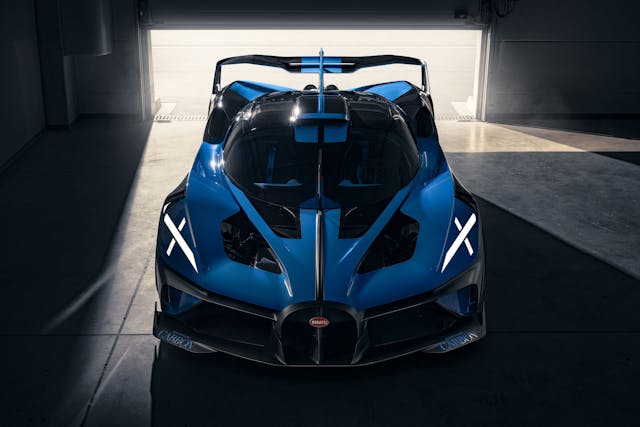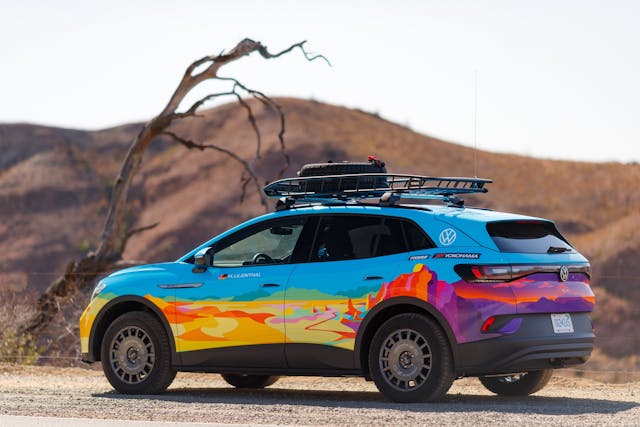Boxster EV to keep mid-engine feel, GM amps up Ultium production, autism can’t slow this 22-year-old
Boxster and Cayman EVs won’t lose their mid-engine character
Intake: Even though the electrified versions of Porsche’s pocket-sized sports cars will have wheel motors, they’ll still feel mid-engined: Porsche plans to mount the batteries amidships. That’s according to a report by Autocar, which says the layout is known as “e-core.” In the recently-revealed Mission R concept (above), with its 718-like dimensions and styling, the batteries are mounted behind the driver and ahead of the rear wheels instead of the now-standard skateboard arrangement, which raise the driving position. This layout would become the basis of the next-generation of Boxster and Cayman, says Autocar.
“With a typical two-door sports car, you see the car is really low because to reduce drag you want the silhouette as low and flat as possible,” Porsche technical chief Michael Steiner says. “To do that you should have the driver sitting as low as possible, and if you do that there is no space for a battery below the seat of the driver. With today’s battery cell technology, the batteries are the biggest and heaviest part of the car—and this could be true for the next decade or so—so we developed what we call the e-core battery design. Packaging-wise and centre of gravity-wise, it’s more or less a copy of a mid-engine design.”
Exhaust: This sounds promising. Although a skateboard chassis keeps battery mass low and drops the center of gravity, we all know that where that mass is positioned is key to a car’s agility. A lower driving position and rear-biased weight distribution could really improve the handling feel of an electric sports car, despite the potential weight penalty over an ICE model.
’Tis the season to go public: Rivian files S-1, Polestar and Volvo to follow suit

Intake: Last Friday, October 1, Rivian filed its S-1 with the SEC to trade publicly on the Nasdaq under ticker “RIVN.” Details in the filing held several points of interest for fans and potential investors alike as to the future of Rivian. Among the pages, the EV startup disclosed $1 billion in net losses, largely accrued from its infrastructure investments and preparations for a September launch of its R1T pickup. Because of that big push, Rivian has successfully beaten Tesla and the Big Three to market with an all-electric consumer pickup. 48,390 total combined preorders are on the books for the R1T truck and the R1S SUV in North America. On its commercial side of things, Rivian remains committed to delivering a big batch of its EDVs (electric delivery vans) to Amazon; that’s 100,000 units by 2025, with 10 such vehicles expected to ship out as early as December of this year. Much unlike Rivian’s traditional proceedings, yet another EV startup, Volvo-owned Polestar, has agreed to go public via SPAC by merging with shell company Gores Guggenheim, Inc. The deal gives Polestar a $20 billion valuation, and it will trade under the ticker “PSNY” on the Nasdaq as well. On the heels of the announcement, Volvo has also said that it plans to raise $2.9 billion in attempts to go public in Stockholm. More details are yet to come for the Swedish marque, though the Wall Street Journal estimates Volvo could get valued at $25 billion. Both Polestar and Volvo are largely owned by Geely Holding Group. Geely previously attempted to take Volvo public in 2018, though the effort failed.
Exhaust: The torrid growth of the electric market has led an astounding number of startup and established automakers to pursue public funds to get a leg-up. Conservative investors will gravitate towards Rivian, its foundational approach, and established, reputable corporate partners. However, that won’t deter a flood of speculative traders who’d rather cross their fingers and bet big on a SPAC darling, like Polestar. Both investor camps hold the promise of much-needed cash for these companies to compete and grow—and, in Volvo’s case, overhaul itself entirely—in the emerging EV industry.
Austin Riley doesn’t let autism slow him down, races to second Canada championship

Intake: Austin Riley did it again. The 22-year-old race car driver, who continues to overcome challenges on and off the track, won his second consecutive Radical Canada East Cup championship over the weekend. Riley, who has autism, headed into the final weekend of competition in second place overall, then rallied to win races on Saturday and Sunday—overcoming radiator problems in the finale—to capture the title. Riley, who is sponsored by Hagerty, is among 5.4 million people age 18 and older who have autism (according to the CDC), a developmental disorder characterized by difficulties with social interaction and communication.
Exhaust: Austin Riley never ceases to amaze. Not only does he excel on the racetrack, but he uses his success to raise autism awareness and inspire others with the same diagnosis. “We want everyone to find the dream that they have, and we want everyone to achieve it,” Austin told NBC Sports last summer. “That’s what’s important in life. To find something you love to do and to do it.”
GM announces two big steps in expansion of Ultium EV strategy

Intake: General Motors announced two major investments in EV tech as it seeks to expand the capability and availability of its Ultium EV platform. The first is a strategic partnership with Wolfspeed, a silicon-carbide device manufacturer that GM will lean on to provide semiconductors for its upcoming, Ultium-based EVs. The lightweight semiconductor material should help expand ranges of the battery-powered vehicles while lowering weight. The second announcement details GM’s plans to invest in a new battery facility on the grounds of its technical campus in Warren, Michigan. The Wallace Battery Cell Innovation Center is scheduled to produce its first prototype cells in late 2022. In addition to investigating tech such as solid-state batteries, the Warren battery plant aims to help lower the cost of future GM electric vehicles.
Exhaust: Hot on the heels of Ford’s massive Blue Oval City EV campus in west Tennessee, GM is looking to make EV headlines of its own. The Wolfspeed partnership seems aimed at reducing the headaches caused by the global semiconductor shortage, which has hampered new vehicle production, and by extension, new vehicle sales.
Bubba Wallace makes NASCAR history

Intake: Bubba Wallace is the first Black driver to win a Cup Series race since NASCAR Hall of Famer Wendell Scott in 1963. Wallace was in the lead on lap 118, of the 188 scheduled, when rain halted the race at Alabama’s Talladega Motor Speedway. Multiple showers passed through the area preventing NASCAR from drying the 2.66-mile oval, and since ’Dega does not have any lights the race could not be run past sunset. Per NASCAR rules, once the leader completes over half the scheduled distance, the race can be legally called. After a lengthy wait, it became clear the race (which was already pushed back one day for rain) would not be able to resume, and Wallace was declared the winner. Not only is this 27-year-old Wallace’s first win in the series, but it is also the first win for freshman team 23XI Racing, a race team owned by Cup star Denny Hamlin and basketball legend Michael Jordan.
Exhaust: Congrats to Wallace and his team. NASCAR fans have witnessed the amount of work the driver has invested over the years to make it to the stock car’s premier division. From his early career wins in the Camping World Truck series to grinding out stellar performances in cars for middle-of-the-pack team Petty Enterprises, his rise to the top ranks has no doubt been tumultuous and well-deserved. His win as a Black athlete in a predominantly Caucasian sport may go far in demonstrating modern-day NASCAR’s inclusivity and will hopefully spark more opportunities for diversity in future rookie classes.
Side note: if you are a devout fan, you also observed the points shakeup post-Talladega, as many Championship front-runners were involved in incidents, relegating them to poor finishes and minimal points. The upcoming race at Charlotte’s Roval should be a spectacular elimination race!
The Bugatti Bolide is officially beautiful

Intake: The Bugatti Bolide has been named the world’s most beautiful hypercar at the glitzy Festival Automobile International in Paris. In a category that included the BAC Mono 2, the Gordon Murray T.50 and Mercedes-AMG One the Bolide was judged by an expert panel of design professionals to be the winner. The Bolide is very much a form-follows-function machine, being essentially a Chiron stripped of all comforts and clothed in track-ready bodywork. “The Bolide was an entirely different challenge for our design team, and a kind of mental experiment where we stripped the car back to its W16 quad-turbocharged heart and rebuild it with the bare minimum to create the most extreme Bugatti yet,” explained Bugatti Design Director Achim Anscheidt. “The key for us was to respect the technical requirements of Bolide, focusing first on the function and only then developing the form. It’s an honour for us that the resulting design has won such a highly coveted award, voted for by experts in our field.”
Exhaust: Beauty is in the eye of the beholder, but at least it gives the 40 Bolide buyers who paid €4 million ($4.65m) each for their hypercars something to talk about while they wait until 2024 to take delivery.
VW preps electric ID.4 for off-road adventure race

Intake: Driver Mercedes Lilienthal and navigator Emily Winslow will campaign an ID.4 AWD Pro in the 2021 running of the Rebelle Rally from October 7 to 16. The all-women rally challenges contestants to navigate through 1400 miles of desert in California and Nevada entirely without digital aids. The SUV has been modified slightly by Tanner Foust Racing and Rhys Millen Racing, who have experience competing with the ID.4 in the NORRA Mexican 1000. While the 295-hp electric powertrain is unmodified, the SUB was beefed up with new suspension components and skid plates. The colorful wrap was designed by artist Liz Kuz. The ID.4 will compete in the crossover class while Rivian, back for the second year in a row, will bring an electric entrant to the 4×4 class.
Exhaust: The kind of rally racing done in the NORRA Mexican 1000 and the Rebelle Rally includes downtime each night, perfect for an electric vehicle that needs to charge for a few hours. Besides batteries adding considerably to the curb weight, there’s no reason to expect an electric vehicle to have any kind of disadvantage in a race like this. We’d much prefer to see an electric dune buggy, considering the Southwestern environment, but the participants will likely appreciate the comfort of doors, a top, and, most importantly, air conditioning.

